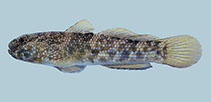| Family: |
Gobiidae (Gobies), subfamily: Gobiinae |
| Max. size: |
6.8 cm SL (male/unsexed) |
| Environment: |
benthopelagic; marine |
| Distribution: |
Western Atlantic: Tobago, Belize, Panama, Curacao, Puerto Rico, the Bahamas, and the Florida Keys; including Mexico and Bermuda.. |
| Diagnosis: |
Dorsal spines (total): 7-7; Dorsal soft rays (total): 9-9; Anal spines: 1-1; Anal soft rays: 8-8. Diagnosis: Pectoral fin rays 18-20 (modally 19); lateral scale rows 38-42; upper jaw length 12.5-15.9 % SL; first dorsal fin with 1-4 dark blotches on each spine, producing 1-4 distinct longitudinal stripes of pigment, stripes fading distally; predorsal squamation reaching anteriorly to vertical through posterior margin of preopercle, sometimes extending slightly beyond this point or falling short just short of it, rarely reaching postorbital spots; trunk with two offset rows of 6-7 dark blotches ventrally, often forming distinctive pattern resembling alternating dark squares on a checkerboard; first row positioned just below lateral midline and extending from beneath pectoral fin to caudal fin base; second row of spots offset from first, positioned just above ventral midline and extending from beneath pectoral fin to caudal fin base; spots in lower row typically more diffuse than spots in upper row, becoming more diffuse posteriorly (Ref. 85559). |
| Biology: |
Exhibits diversity of habitat preference, from shallow warm pools formed in limestone on exposed beaches with moderate wave action, from sheltered intertidal pools on rock and pebble shorelines of bays or coves, on reef crests, and over silt and mud around mangrove roots (Ref. 85559). |
| IUCN Red List Status: |
Least Concern (LC); Date assessed: 01 March 2010 Ref. (130435)
|
| Threat to humans: |
harmless |
Source and more info: www.fishbase.org. For personal, classroom, and other internal use only. Not for publication.

